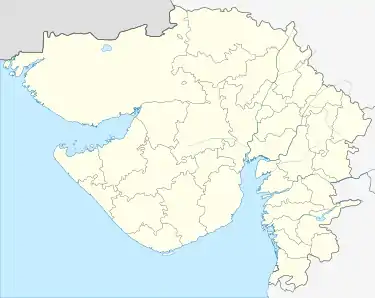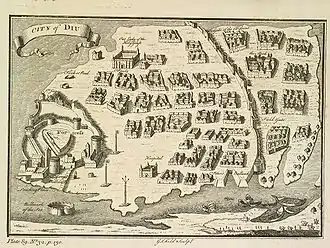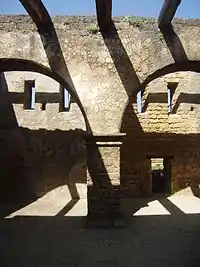Diu Island
Diu Island is an island off the Southern coast of Gujarat's Kathiawar peninsula, separated from the mainland by a tidal creek. It has an area of 40 km², and a population of 44,110 (2001 census).
Diu Island
દમણ અને દીવ Div / Dio | |
|---|---|
Island | |
 | |
 Diu Island | |
| Coordinates: 20°42′53.9″N 70°59′26.1″E | |
| Country | |
| Union Territories | |
| District | Diu |
| Government | |
| • Type | Panchayat |
| Area | |
| • Total | 38.8 km2 (15.0 sq mi) |
| Elevation | 8 m (26 ft) |
| Population (2015) | |
| • Total | 44,215 |
| • Density | 1,100/km2 (3,000/sq mi) |
| Time zone | UTC+5:30 (IST) |
| Website | www.diu.gov.in |
It belongs to Diu District and lies 5 km to the east of Diu Head. Diu is part of the Union territory of Dadra and Nagar Haveli and Daman and Diu. Both Daman and Diu share the same member of parliament.

The town of Diu and Diu Fort are located on the island. There is also a domestic airport, Diu Airport.

Churches
St Paul's Church
The construction of this church was started in 1601 and was completed by 1610. The Church is dedicated to Our Lady of Immaculate Conception in 1691. Illuminated by flood lights (by night time), the main façade of the church is perhaps the most elaborate of all Portuguese churches in India. In architectural style, the is Gothic and resembles Bom Jesus Church at Old Goa. The wood - panelling of the church is rated one of the best in church craftsmanship. The church adorned with curiously treated volutes and shell - like motifs and the magnificent wood carving. [1]
St. Thomas Church
Now a museum, the old St. Thomas Church houses antique statues, various stone inscriptions of the earlier rulers, wooden carvings and idols. The huge edifice in gothic architecture was built in 1598. A part of it has been converted into a museum - an archaeological treasure house. The artifacts displayed date back to the 16th century and beyond.[2]
Forts
Diu Fort

The Diu Fort, is located on the west coast of India in Diu, a Union Territory, administered by the Government of India. The fort was built by the Portuguese during their colonial rule of the Diu island. The Diu town is located to the west of the fort. The fort was built in 1535 subsequent to a defense alliance forged by Bahadur Shah, the Sultan of Gujarat and the Portuguese when Humayun, the Mughal Emperor, waged war to annex this territory. Some additions made in 1541 and the fort was strengthened over the years, till 1546. Portuguese ruled over this territory from 1537 (from the year they took control of the fort and also the Diu town fully) until 1961. They were forced to quit only in December 1961 (even though India became an independent country in 1947) during a military action called the Operation Vijay launched by the Government of India, and thereafter Diu was annexed by India as a centrally administered Union Territory.[3]
This massive, fairly well-preserved Portuguese fort with its double moat must once have been impregnable. But years of sea erosion and neglect are leading to its slow collapse. Cannonballs litter the place, and the ramparts have a superb array of cannons. The lighthouse is Diu's highest point, with a beam that reaches 32 km in every direction. There are several small chapels, one holding engraved tombstone fragments. Part of the fort also serves as the island's jail.[4]
Fortim do Mar
Built right at the mouth of the creek, the fortress of Fortim do Mar (Sea Fort or Pani-Kotha) is a magnificent stone structure in the sea. Approximately one nautical mile (1.852 km) from the Diu jetty, it also has a light house and a small chapel dedicated to Our Lady of the Sea. The fortress creates a beautiful view whether seen from the jetty, from the villages of Ghoghla or from Diu proper, or from the Fort itself.[5]
| Wikivoyage has a travel guide for Diu. |
References
- "St. Paul's Church, Diu - India ..." Official Website of Daman and Diu Tourism Department. Retrieved 2009-10-18.
- Shetty, Sneha. "Have you visited these churches in Diu?". india.com. Retrieved 4 January 2021.
- Ramchandani, Indu; Dale Hoiberg (2000). Students' Britannica India: Select essays. Diu Fort. Popular Prakashan. pp. 398–400. ISBN 978-0-85229-762-9. Retrieved 2009-10-14.
- Elton, Geoffrey Rudolph (1990). The New Cambridge Modern History: The Reformation, 1520–1559. Europe and the East. Cambridge University Press. p. 673. ISBN 978-0-521-34536-1.
- "Fortim do Mar Diu". Gujarat Orbit. Retrieved 4 January 2021.
